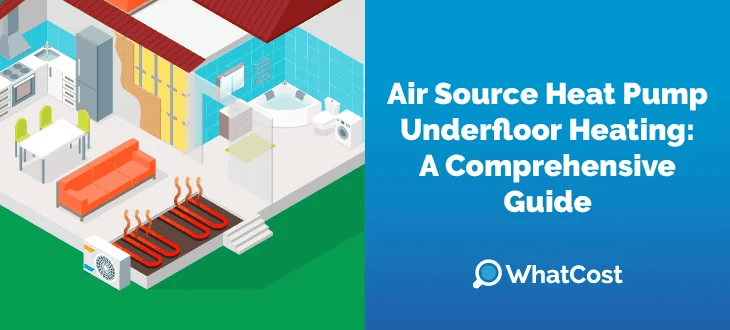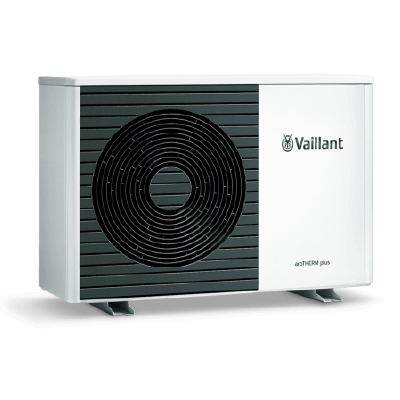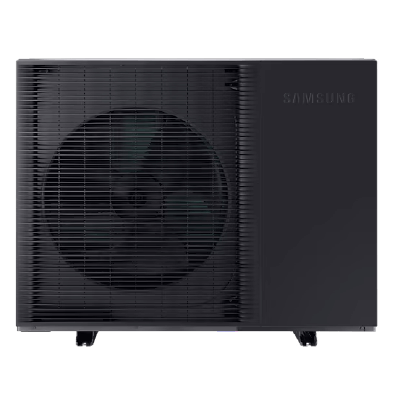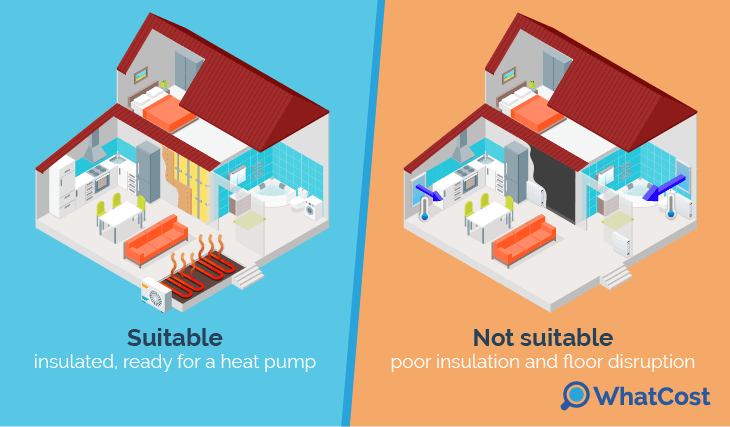Answer these simple questions and we will find you the BEST prices
Which type of solar quotes do you need?
It only takes 30 seconds
100% free with no obligation

Get up to 4 quotes by filling in only 1 quick form

Install a heat pump for less with the BUS grant

Increase the value of your home by installing a heat pump
- whatcost.co.uk
- Heat Pumps
- ASHP Underfloor Heating
Air Source Heat Pump Underfloor Heating: A Comprehensive Guide


- Underfloor heating with an air source heat pump suits most UK homes, but works best in well-insulated properties.
- Installation costs typically range from £12,000 - £22,000, covering both systems and professional fitting.
- The biggest benefits are steady warmth, lower running costs, and freeing up wall space compared to traditional radiators.
When you combine underfloor heating with air source heat pumps (ASHPs), you create a highly efficient system that delivers steady, low-cost warmth throughout your home. With typical UK household energy bills still 43% higher than winter 2021/2022 levels (House of Commons Library), improving your home’s efficiency is a smart and practical necessity.
In this guide, we explain how underfloor heating with heat pumps works, what it costs, and what to consider before arranging your air source heat pump installation.
If you’re planning a new build, upgrading your heating system, or improving your home’s insulation, getting the right advice early on can make a big difference.
To save hours of research, we connect you with up to 4 accredited heat pump specialists, so you can easily compare quotes, system options, and timelines, with no pressure and no cost.
Start by answering a few quick questions. It only takes 30 seconds.
- Quotes from local installers
- Payment by finance available
- Save £7,500 with BUS grant
It only takes 30 seconds

- How does a heat pump underfloor heating work?
- How much does underfloor heating with an air source heat pump cost?
- Is underfloor heating with an air source heat pump suitable for every household?
- The best underfloor heating air source heat pump
- Heat pump underfloor heating advantages
- Heat pump underfloor heating disadvantages
- Is underfloor heating with a heat pump the right choice for my household?
- FAQ
How does a heat pump underfloor heating work?
When an underfloor heating system connects to an air source heat pump, it uses low-temperature water to warm your home steadily and efficiently. The heating system runs on the ground floor, heating from beneath the surface, often lifting the floor or making space for pipework.
Let’s break down how the full process works:
The system goes through 4 stages to produce heating:
Stage 1: Heat extraction
With an air source heat pump installed outside your home on a wall or a solid base (such as a concrete pad), the system pulls in air from outside. Even in temperatures as low as -15 °C, modern ASHPs can still extract usable heat, as confirmed by iHeat, which notes they operate efficiently in sub-zero conditions.
Fans pull outside air across the evaporator coil, where the refrigerant absorbs heat and turns into a gas.
Stage 2: Heat compression
After the refrigerant absorbs heat from the air, it flows into the compressor inside the outdoor unit. This process squeezes the refrigerant, increasing its pressure and temperature to create usable warmth. For underfloor heating, the ideal flow temperature is between 40o C and 45 o C, a range recommended by UK underfloor specialist Nu-Heat for maintaining comfort and energy savings.
Stage 3: Warming the water and floor
Once compressed, the hot refrigerant enters a heat exchanger. Here, its heat is transferred to water, raising the water temperature, typically to 35oC - 45oC. This level is ideal for wet underfloor heating systems. This system uses warm water pumped through pipes beneath the floor, unlike electric systems that rely on heating cables.
This warm water is then pumped through pipes laid beneath your floor, gently heating the surface. The heat rises evenly upwards from wherever the pipes run, maintaining safe floor temperatures between 25 o C and 28 °C, as recommended by British Standard EN 1264.
How much does underfloor heating with an air source heat pump cost?
Installing underfloor heating with an air source heat pump system costs £12,000 to £22,000 for a standard 3-4 bedroom UK home (around 90- 110m2). This includes the heat pump system, wet underfloor system for the ground floor, basic floor prep, and professional installation.
| Item | Estimated cost range |
|---|---|
| Air to water heat pump | £11,000 - £13,500 |
| Wet underfloor heating system (ground floor) | £5,000 - £15,000 |
| Installation labour (3-4 beds) | £2,400 |
| Annual maintenance (recommended) | £120 - £245 |
Typical total installation cost: £12,000 - £22,000
This includes:
- The heat pump unit
- Underfloor pipework
- Manifolds and standard controls
Extra costs to consider:
- Poor insulation
- Complex layout or structural changes
- Additional materials for non-standard floor types
Regional factors can affect pricing. For example, installing heat pumps in Scotland or heat pumps in Wales may require system adjustments to suit colder climates or local regulations.
To offset those costs, you might qualify for a heat pump grant in the UK, offering up to £7,500 off the upfront cost through the Boiler Upgrade Scheme, depending on your location and the system you choose. If you’re installing a heat pump in Northern Ireland, options may vary based on local funding and support.
To gauge what it would cost for your UK home, it’s best to get an accurate heat pump quote based on your property size, current heating system, floor construction, and energy needs.
Use our quick 30-second form below to get matched with up to 4 qualified heat pump installers who understand your property type and heating needs.
It’s the fastest way to compare real options side by side without spending hours researching companies yourself.
More than 70% of users matched through our service said they were satisfied with their installer and felt more confident in their decision.
There’s no cost and no obligation, just a simple way to explore your options.
Click below to compare heat pump quotes and installers near you.
- Quotes from local installers
- Payment by finance available
- Save £7,500 with BUS grant
It only takes 30 seconds

Is underfloor heating with an air source heat pump suitable for every household?
No, underfloor heating with an air source heat pump doesn’t suit every household. Your property must meet certain conditions for the system to be a practical choice.
- The home is well insulated (walls, floors, loft).
- The property has solid floors like concrete or screed.
- There is an outdoor space (including outdoor walls) for a heat pump and an indoor space for a hot water cylinder.
- You’re building a new home, carrying out a major renovation, or upgrading your full heating system.
- You’re switching away from oil, LPG, or direct electric heating.
- The home is poorly insulated and loses heat quickly through windows, doors, walls.
- The house has suspended timber floors without easy access to pipework.
- There’s no outdoor space to install a heat pump.
- You’re only making small improvements and cannot lift or replace existing floors.
- You intend to use electric underfloor heating with a heat pump (not recommended).
If your home fits more into the second group, consider upgrading your insulation as a first step. You can also compare ground source heat pumps, which may be more suitable for certain properties.
The best underfloor heating air source heat pump
The best choice for underfloor heating is a low-temperature air to water heat pump. Top models include the Vaillant aroTHERM Plus, Samsung EHS Mono, and Mitsubishi Ecodan.
These systems provide steady heat at flow temperatures between 35°C and 45°C, which matches how wet underfloor heating systems distribute warmth.
When choosing your system, it’s important to consider the heat pump size, especially if you’re heating multiple floors or larger homes.
Here are three top-rated air source heat pumps for underfloor heating available in the UK:
Vaillant aroTherm Plus

This quiet, MCS-certified system operates at around 54 dB (A) and uses the natural refrigerant R290 for greater efficiency. It can achieve flow temperatures of up to 70°C, making it a suitable high temperature heat pump for homes that need higher heat output. It’s also ideal for well-insulated homes up to 150 m2 with underfloor heating.It's especially popular in retrofitted homes where radiators remain, and works efficiently with both underfloor and traditional systems. Vaillant confirms that the aroTHERM Plus is "ideal for use with underfloor heating, radiators and fan coils," making it suitable for both new builds and retrofit installations.
Samsung EHS Mono

The Samsung EHS Mono works in temperatures from -25 °C to +35 °C, which is ideal for the UK’s variable climate. Its Seasonal Coefficient of Performance (SCOP) is around 4.5, which means it produces roughly 4.5 units of heat for every unit of electricity it uses, measured across a full heating season.It’s compact, all-in-one outdoor unit stands at around 1 metre tall, making it suitable for homes with limited external space.It can comfortably heat properties with a floor area of around 120m2 to 140m2, depending on how well the home is insulated.
Mitsubishi Ecodan

A flexible, quiet model that supports homes ranging from 90 m² to over 200 m², depending on insulation. All models are MCS certified and can be equipped with an integrated heat pump water heater, providing a combined hot water supply and heating system.
Heat pump underfloor heating advantages
Installing an underfloor heating system with a heat pump can lower your energy bill by up to 25 - 40% compared to a standard gas boiler. It also frees up space by removing bulky radiators and spreads gentle, even warmth throughout each room.
According to the Energy Saving Trust, switching from an old G-rated gas boiler to a heat pump can save around £290, with even more savings if you’re replacing electric heating.
| Advantage | Why it matters |
| Lower bills | Use water at 35 – 45 °c, cutting energy use and reducing heating costs by up to 40%. |
| Even room temperatures | Heat rises evenly from the floor, avoiding cold spots or temperature swings. |
| More space to live in | No radiators needed, giving you more flexibility for furniture and layouts. |
| Quiet operation | Runs with minimal noise, quieter than most gas boilers and radiator clicks. |
| Lower carbon footprint | Uses outside air as a heat source, helping reduce your home’s emissions. |
These benefits make heat pump underfloor heating one of the most efficient and comfortable options in modern UK homes.
Heat pump underfloor heating disadvantages
The main drawbacks of heat pump underfloor heating include higher installation cost, disruption during installation, and slower heat-up time compared to radiators.
| Disadvantage | Why it matters |
| High upfront cost | Installing both systems can cost £12,000 – £22,000 before any available grants. |
| Slower heat-up time | Takes longer to warm a room than a radiator system. |
| Needs good insulation | Works best in homes that retain heat well. |
| Floor disruption | Pipes may require lifting flooring, which can be messy or expensive. |
| Not suited to electric underfloor heating | Best results come with water-based (wet) systems, not electric ones. |
Is underfloor heating with a heat pump the right choice for my household?

Yes. It’s a good fit if your home is well-insulated, and you’re renovating.
No. It’s less suitable if your home loses heat easily or you can’t make changes to your floors.
Underfloor heating with a heat pump works best in homes that hold in warmth. Good insulation helps stop heat from escaping through walls, floors or windows.
That’s because heat pumps warm your home using water (at 35 to 55o C, best for underfloor heating), which is lower than 70 - 80oC temperatures used by traditional boilers. Lower temperatures use less energy, but only work well if your home can retain the heat.
But to keep your home warm with that lower heat, the warmth must stay inside. That’s why insulation plays such an important role.
If your home meets these conditions, the next step is to look at costs and see if any financial support is available.
To help with that, you can use our free quote service instead of spending hours researching companies that install both underfloor heating and air source heat pumps.
Use our 30-second form to get matched with up to 4 qualified heat pump specialists and compare quotes, completely free.
- Quotes from local installers
- Payment by finance available
- Save £7,500 with BUS grant
It only takes 30 seconds

FAQ
Yes, underfloor heating works well with an air source heat pump by using low-temperature water (35o C to 45o C) to heat rooms evenly from below the floor surface. This setup is most effective in well-insulated homes with suitable floor space for pipework.
Air source heat pumps typically run at 35 °C to 45 °C with underfloor heating. This lower flow temperature suits how wet underfloor systems spread heat gently and evenly across the room.
The main advantage is lower running costs. By using water temperatures between 35°C and 45°C, the system can slash heating bills by up to 40%. It also provides more even warmth and frees up space by removing radiators.
Yes, air source heat pumps can work with both, but they perform best with water-based underfloor heating. This is because both systems operate efficiently at lower temperatures. Radiators may need to be upgraded to maintain comfort levels.
Based on current figures October 2025, the total cost to install an air source heat pump with underfloor heating ranges from £12,000 to £22,000 for a typical 3-4 bedroom UK home. This includes the heat pump, wet underfloor system, installation, and basic floor preparation.

Rousanna is an SEO content writer at WhatCost with a background in digital marketing and copywriting. She creates informative, well-researched home improvement content based on practical ideas to help readers make informed decisions.
- Air Source Heat Pump Underfloor Heating: A Comprehensive Guide
- How does a heat pump underfloor heating work?
- How much does underfloor heating with an air source heat pump cost?
- Is underfloor heating with an air source heat pump suitable for every household?
- The best underfloor heating air source heat pump
- Heat pump underfloor heating advantages
- Heat pump underfloor heating disadvantages
- Is underfloor heating with a heat pump the right choice for my household?
- FAQ
- Quotes from local installers
- Payment by finance available
- Save £7,500 with BUS grant
It only takes 30 seconds

